Listen to the Podcast
27 Oct 2023 - Podcast #855 - (15:02)
It's Like NPR on the Web
If you find the information TechByter Worldwide provides useful or interesting, please consider a contribution.

If you find the information TechByter Worldwide provides useful or interesting, please consider a contribution.
I’ve used AeroAdmin for several years when I need to help friends with computer problems, but it gave me a way to use my home computer when I spent a month in an assisted living facility following surgery.
Click any small image for a full-size view. To dismiss the larger image, press ESC or tap outside the image.
 Although AeroAdmin’s restrictions for free usage are quite liberal, I needed a paid account because I wanted a full-time connection. The free license allows for up to 17 hours of use with up to 20 users per month. That’s more than adequate if I simply need to connect occasionally to a friend’s computer for an hour or so. It wasn’t enough when I needed to work with files on my home computer.
Although AeroAdmin’s restrictions for free usage are quite liberal, I needed a paid account because I wanted a full-time connection. The free license allows for up to 17 hours of use with up to 20 users per month. That’s more than adequate if I simply need to connect occasionally to a friend’s computer for an hour or so. It wasn’t enough when I needed to work with files on my home computer.
When I needed full-time access to my home computer, the free plan wasn’t enough. >>
The free account also doesn’t include the ability to transfer files from one computer to the other, and that’s a feature I needed when I couldn’t sit in front of the computer at home.
Before programs like LogMeIn, TeamViewer, and AeroAdmin came along, trying to help someone solve a computer problem was difficult. We’d talk on the phone and they would describe the problem. (“It said there was a problem with something, but I didn’t write it down.”) Then I would suggest some actions and ask them how the computer responded. Usually they would fail to mention at least one crucial clue. I’d ask “Have you changed or updated anything or have you installed any new applications?” The most common answer is NO, because they thought a Windows update didn’t count or they forgot the application they installed last week, the one that contained a virus. So no, of course "nothing" has changed.
Most users will accurately perform any actions requested, but all too often they perform extra steps they think might be useful without mentioning them, or they anticipate what they think you’ll ask them to do and accidentally make the situation worse.
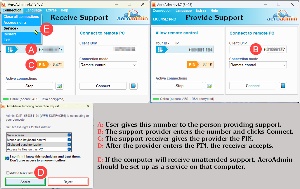 AeroAdmin is one of several applications that allow those of us who provide support, either commercially or free for friends and family, to work on the computer as if we were sitting in front of it. I’ll describe just AeroAdmin because it’s free for limited use and it’s easy to use.
AeroAdmin is one of several applications that allow those of us who provide support, either commercially or free for friends and family, to work on the computer as if we were sitting in front of it. I’ll describe just AeroAdmin because it’s free for limited use and it’s easy to use.
Those who provide support commercially may find that TeamViewer or LogMeIn to be worth the price, but AeroAdmin packs a lot of functionality into its least expensive offering and even the free version.
You may think that you can use an application such as Zoom to provide support because screen sharing is supported. But Zoom hides User Access Control warnings and disallows mouse control for some applications. Unless you enjoy being frustrated, don’t try it.
 The free version of AeroAdmin doesn’t support file transfers, so I signed up for a Pro account late last year when I needed to be able to use my home computer from the assisted living facility where I stayed for a month. The home computer has three screens and AeroAdmin shows all of them on connection. Depending on the size and number of screens the support provider’s computer has, it may be necessary to limit the view to just one of the three screens.
The free version of AeroAdmin doesn’t support file transfers, so I signed up for a Pro account late last year when I needed to be able to use my home computer from the assisted living facility where I stayed for a month. The home computer has three screens and AeroAdmin shows all of them on connection. Depending on the size and number of screens the support provider’s computer has, it may be necessary to limit the view to just one of the three screens.
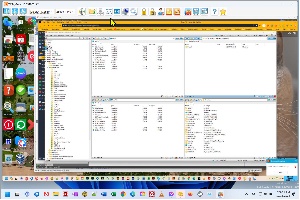 When the person providing support restricts the view to a single monitor, it’s almost like sitting in front of the other computer.
When the person providing support restricts the view to a single monitor, it’s almost like sitting in front of the other computer.
The free version of AeroAdmin (which can be used for personal or commercial applications) has a limit of 17 hours per month per computer. You can provide a lot of family-and-friends support in 17 hours. That became a problem only when I needed access for several hours every day for a month.
There are some some other nice-to-have features in the paid version ($119 per year), but the free version is more than enough for in many cases. If you need to connect to more than 20 computers per month or use AeroAdmin for more than 17 hours per month on any one computer, you will need the Pro version, which also includes the ability to transfer files, a list of contacts and their computer ID numbers. But even the free version supports to connections with computers that have more than one screen.
For more information on either the free or paid versions, see the AeroAdmin website.
It’s possible to use ChatGPT to generate text about a subject, text that you can then edit. But it’s also possible to hand off your text to a bot for rewriting. QuillBot is an example of this.
Click any small image for a full-size view. To dismiss the larger image, press ESC or tap outside the image.
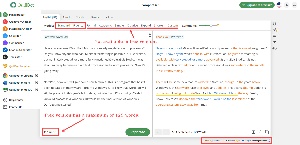 QuillBot can be used for free, but it’s quite limited. It will paraphrase up to 125 words of your text using one of the two free modes. With a paid premium plan, there are no text limits and you can choose from eight paraphrase modes such as formal, academic, simple, creative, expand, and shorten or create a new academic, witty, or optimistic mode.
QuillBot can be used for free, but it’s quite limited. It will paraphrase up to 125 words of your text using one of the two free modes. With a paid premium plan, there are no text limits and you can choose from eight paraphrase modes such as formal, academic, simple, creative, expand, and shorten or create a new academic, witty, or optimistic mode.
Is it worth $100 per year? Let’s take a look at what it can do. The two modes available for free are standard and fluency. I started with some text from a previous edition of TechByter Worldwide and asked QuillBot to paraphrase it.
Farewell WordPad
Have you ever used WordPad, Microsoft’s nearly weightless word processor? Do you know anyone who has? Minimal formatting is possible in (1) WordPad, but not in (2) Notepad, or a more fully functioned (3) UltraEdit Studio. It was about midway between a plain text processor and a word processor. Now it’s going away.
NotePad, however, will gain some new features. This is a program that hasn’t been updated in many years—prior to Windows 8. It’s likely that WordPad will still be present in this year’s fall update, but Windows 12 is coming. (Yeah, I know, Microsoft said Windows 10 would be the final version of Windows. Don’t get me started.)
Goodbye, WordPad
Have you ever used WordPad, the almost weightless word processor from Microsoft? Anyone you know who has? In (1) WordPad, minimal formatting is possible, but not in (2) Notepad or a more feature-rich (3) UltraEdit Studio. It stood in the middle of a plain text editor and a word processor. It is now fading away.
But NotePad will get some additional capabilities. Prior to Windows 8, this program hasn't received any updates in a very long time. WordPad will probably still be available in this year's fall update, but Windows 12 is on the way. (Yes, I am aware that Microsoft declared Windows 10 to be the last release of Windows. Don't even start with me.)
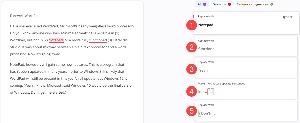 Good or bad? That’s for you to decide. Is the paraphrased text an improvement? Although the differences are minimal and the resulting text seems mostly OK, there’s at least one verb tense that miscommunicates what I intended. The the paraphrased text no longer sounds like I wrote it.
Good or bad? That’s for you to decide. Is the paraphrased text an improvement? Although the differences are minimal and the resulting text seems mostly OK, there’s at least one verb tense that miscommunicates what I intended. The the paraphrased text no longer sounds like I wrote it.
Additionally, some of the comments and suggestions are either off-base or nonsense. The suggestion to replace “Notepad” with “Notepad” is in the latter category.
The developer says QuillBot will improve your fluency while also ensuring you have the appropriate vocabulary, tone, and style for any occasion. “Simply enter your text into the input box, and our AI will work with you to create the best paraphrase.“
The user can adjust the program to increase or decrease the number of synonyms used.
The eight predefined modes are described this way:
The ninth option, Custom, rewrites text based on a description you provide of the desired writing style.

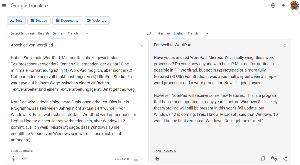 QuillBot can also translate your text from English to one of more than 20 other languages. It claims to understand English idioms for US, UK, Canadian, and Australian dialects. The free version claims to have no limits for its translation service.
QuillBot can also translate your text from English to one of more than 20 other languages. It claims to understand English idioms for US, UK, Canadian, and Australian dialects. The free version claims to have no limits for its translation service.
I gave QuillBot the “Farewell WordPad” text and asked for a German translation. Because I don’t speak or read German, I can’t say whether the translation is any good. One way to check overall accuracy, though, involves having the translator examine the German text and provide output in English. The result seemed to be acceptably accurate.
Any translation for business, legal, or diplomatic uses should always make use of a human translator who is familiar with both languages.
The paid version of QuillBot also includes a plagiarism checker, a co-writer service that claims to work interactively with the writer, and plug-ins for some web browsers and word processors. To learn more or to try QuillBot for free, visit the company’s website.
You may already know how to synchronize the Windows clipboard between two Windows computers, but did you know that you can also sync the clipboard with your Android phone? You’re out of luck if you have an Apple phone, but it’s easy with Android. In fact, it will probably take you longer to read how to set it up than you’ll need to actually set it up.
Click any small image for a full-size view. To dismiss the larger image, press ESC or tap outside the image.
On Windows 10, search for Clipboard in the settings panel. Turn on the option to sync across devices and make sure that Automatically sync text that I copy is selected. On Windows 11, the Clipboard is near the bottom of the System page. Turn on Clipboard History if it’s not already on, the Turn on the option to sync across devices and make sure that Automatically sync text that I copy is selected.
If you have these same settings on another computer where you log in with the same Windows account, the Clipboard will be synced between the computers.
Next you’ll need to install Microsoft’s SwiftKey app on your phone. You’ll find it in the Play store. Install it and then choose Enable Swiftkey, make it your default input method, and sign in to your Microsoft account.
When you copy something on your phone, it’ll be synced to your PC’s clipboard and when you copy something on your PC, it’ll be synced to the SwiftKey keyboard on your phone.
Occasionally I hear complaints that applications such as Adobe Firefly allows photographers to lie. That is inaccurate. From the day photography was invented, photographers have been able to make their images lie. Civil War photographers sometimes composited images to create scenes that never existed. Photographs of the Soviet Politburo were routinely edited to eliminate those who had fallen out of favor with Stalin. Those images lied and applications such as Photoshop and Firefly make image modification easier. But that’s not always bad; consider this:
Would an artist who works with paint on canvas include the wires, the bare tree, the large black pole, the light fixtures, the irrigation device, and the spot in the center without vegetation in this photograph of the Inniswood Metro Gardens entrance? Or would that artist paint what people actually see in their mind’s eye when they recall driving into the park?
The lower image is probably what you would remember if you have ever driven or walked here. Firefly simply eliminates the things our minds ignore in the real world.

Removing the pole at the right turned out to be quite difficult. Firefly replaced the pole with a pole, replaced it with a mis-shaped pole, replaced it with a shorter pole, and replaced it with a light fixture that had no connection to the pole. Power lines can also be a problem for Firefly and sometimes simply using the clone tool is faster and easier. But Firefly did an amazing job on the light fixtures, the objects in the foreground, and the bare trees in the background.
So does this image lie? In my estimation, it does not.